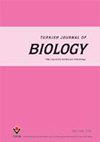基于活性炭零点电荷的三丁酸甘油三酯检测的安培生物传感器
IF 0.9
4区 生物学
Q3 BIOLOGY
引用次数: 7
摘要
制备了一种检测甘油三酯(TG)的单酶传感器。用活性炭对石墨棒进行改性,并将其作为固定化脂肪酶的载体。壳聚糖(CHIT)最终用于在生物电极上形成膜并保留固定化酶。为了扩大热重检测的线性范围,先用羧基再用胺基(AAC)对AC进行功能化,以提高AC的等电点。利用循环伏安法和场发射扫描电镜(FE-SEM)对构建的石墨/AAC/脂肪酶/CHIT生物电极进行了表征。通过测定缓冲液中不同浓度的三丁酸甘油酯(TB)来评价所研制的生物传感器的准确性。在50 ~ 350 mg dL-1范围内呈线性关系,检出限为9.9 mg dL-1。该传感器灵敏度为0.16 μA mg-1 dL。用所构建的生物传感器对几种人血清样品的TG检测结果与全自动生化分析仪的结果吻合较好。制备的生物传感器不受多种人血清材料的影响,具有较强的抗干扰能力。重现性和重复性试验的相对标准偏差分别为3.46%和2.94%。本文章由计算机程序翻译,如有差异,请以英文原文为准。
Amperometric biosensor for detection of triglyceride tributyrinbased on zero point charge of activated carbon
A simple and robust single enzyme biosensor was fabricated for triglyceride (TG) detection. Graphite rods were modified with activated carbon (AC) and used as support for lipase immobilization. Chitosan (CHIT) was eventually used to create film on the bioelectrode and retain the immobilized enzyme. To extend the linear range of TG detection, AC was functionalized with carboxyl and then amine groups (AAC) to enhance the isoelectric point of AC. The constructed graphite/AAC/lipase /CHIT bioelectrode was characterized using cyclic voltammetry and field emission scanning electron microscopy (FE-SEM). The accuracy of the developed biosensor was assessed through determination of different concentrations of tributyrin (TB) in buffer solution. Linear responses were found for TB concentration in the range of 50 to 350 mg dL-1 with a detection limit of 9.9 mg dL-1. The biosensor showed good sensitivity of 0.16 μA mg-1 dL. The detected level of TG in several human serum specimens using the constructed biosensor was in good agreement with the results of an automatic biochemical analyzer. The fabricated biosensor was not affected by a number of human serum materials and showed a strong anti-interference ability. The relative standard deviation in reproducibility and repeatability tests was 3.46% and 2.94%, respectively.
求助全文
通过发布文献求助,成功后即可免费获取论文全文。
去求助
来源期刊

Turkish Journal of Biology
BIOLOGY-
CiteScore
4.60
自引率
0.00%
发文量
20
审稿时长
6-12 weeks
期刊介绍:
The Turkish Journal of Biology is published electronically 6 times a year by the Scientific and Technological
Research Council of Turkey (TÜBİTAK) and accepts English-language manuscripts concerning all kinds of biological
processes including biochemistry and biosynthesis, physiology and metabolism, molecular genetics, molecular biology,
genomics, proteomics, molecular farming, biotechnology/genetic transformation, nanobiotechnology, bioinformatics
and systems biology, cell and developmental biology, stem cell biology, and reproductive biology. Contribution is open
to researchers of all nationalities.
 求助内容:
求助内容: 应助结果提醒方式:
应助结果提醒方式:


